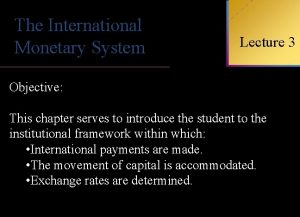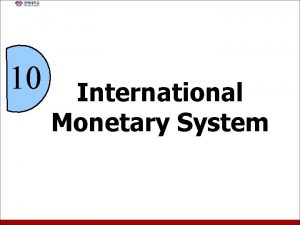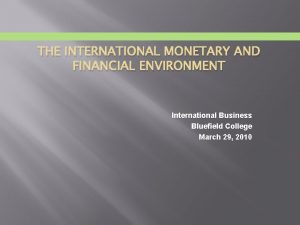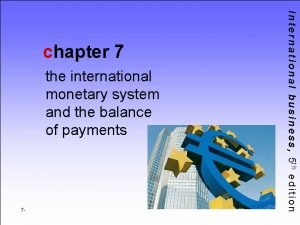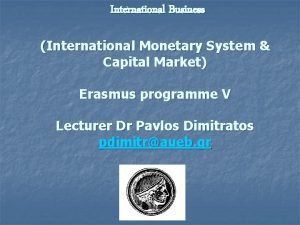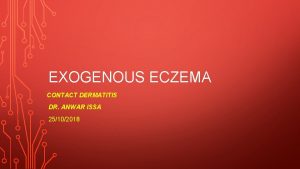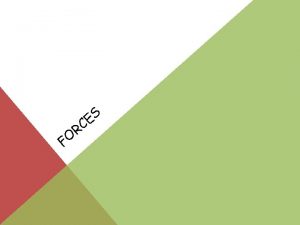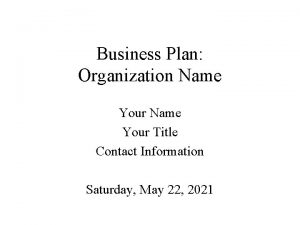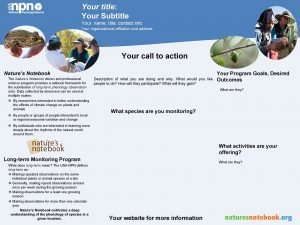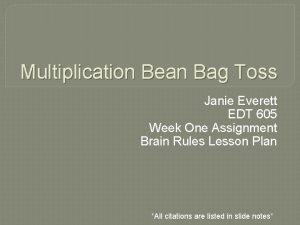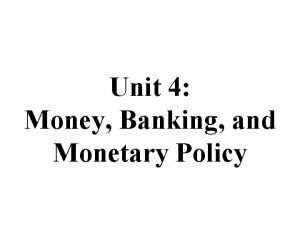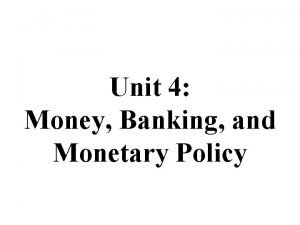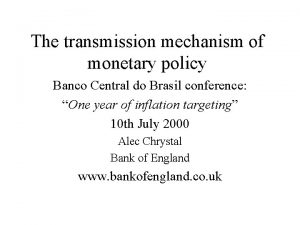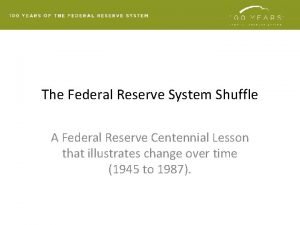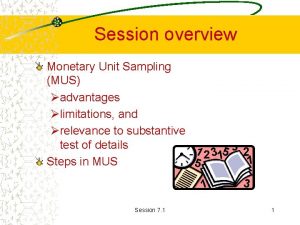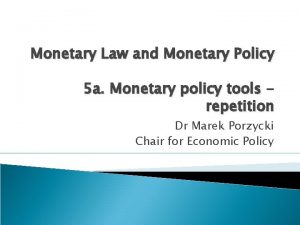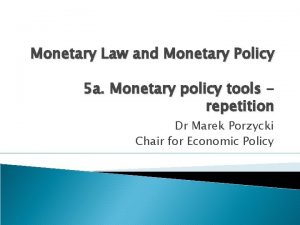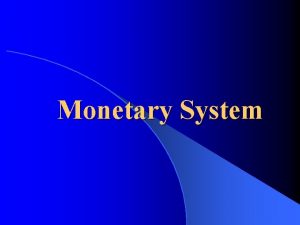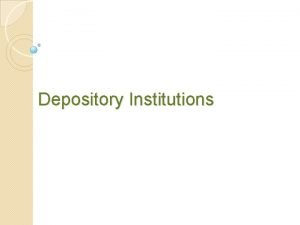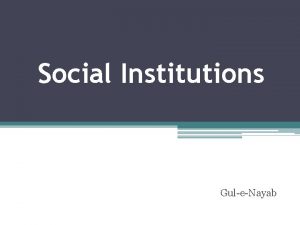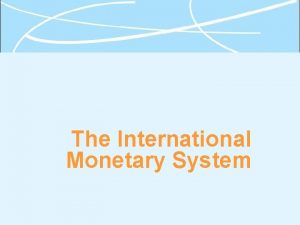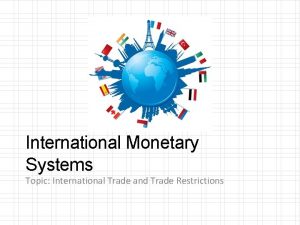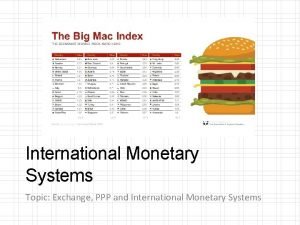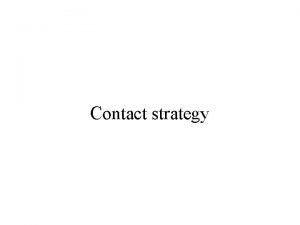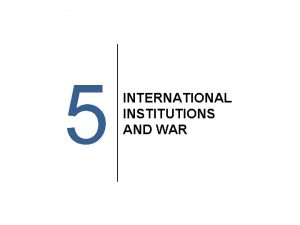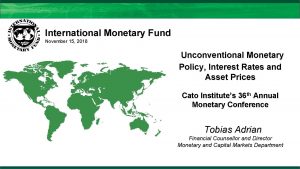International Monetary Systems Topic International institutions Contact Information




































- Slides: 36

International Monetary Systems Topic: International institutions

Contact Information and website • Dr. Dave Mc. Evoy • Associate Professor of Economics • Appalachian State University, NC 28608 • Email: mcevoydm@appstate. edu • Course Website: davemcevoy. weebly. com/imsangers 2018. html

Group Work: Big Mac Index (January 2017) Use the prices of the Big Mac to estimate the real exchange rates for the United States with: Recall reach exchange is computed as foreign price (in $) / US price ($) France Real = Nominal = E$/Foreign = 1. 046 Switzerland Real = Nominal = E$/Foreign = 0. 9769 South Africa Real = Nominal = E$/Foreign = 0. 0718 Hungary Real = Nominal = E$/Foreign = 0. 0034

Group Work: Big Mac Index (January 2017) Use the prices of the Big Mac to estimate the real exchange rates for the United States with: Recall reach exchange is computed as foreign price (in $) / US price ($) France Real = 4. 29 / 5. 06 = 0. 848 Nominal = E$/Foreign = 1. 046 Switzerland Real = 6. 35/5. 06 = 1. 25 Nominal = E$/Foreign = 0. 9769 South Africa Real = 1. 89/5. 06 = 0. 374 Nominal = E$/Foreign = 0. 0718 Hungary Real = 3. 05 / 5. 06 = 0. 603 Nominal = E$/Foreign = 0. 0034

Group Work: Big Mac Index (January 2017) What would the exchange rate have to be for purchasing power parity (PPP) to hold? France Nominal = E$/Foreign = 1. 046 Switzerland Nominal = E$/Foreign = 0. 9769 South Africa Nominal = E$/Foreign = 0. 0718 Hungary Nominal = E$/Foreign = 0. 0034

Group Work: Big Mac Index (January 2017) What would the exchange rate have to be for purchasing power parity (PPP) to hold? France Nominal = E$/Foreign = 1. 046 PPP = 1. 234 Switzerland Nominal = E$/Foreign = 0. 9769 PPP = 0. 7785 South Africa Nominal = E$/Foreign = 0. 0718 PPP = 0. 1922 Hungary Nominal = E$/Foreign = 0. 0034 PPP = 0. 0056

Historic US Dollar – Franc Exchange Rate 1958 - 2013 What was going on here with the US dollar – Franc Exchange Rate?

Broad types of exchange systems • Floating • Let the markets decide the exchange rate (supply and demand) • Fixed (or pegged) • Deliberate efforts are made to fix the exchange rate to some target or within a defined band (e. g. , + and – 2%)

The bimetallic standards (gold and silver) • Example: France (Monetary Law of 1803) required MINT to supply gold and silver coins at ratio of 15. 5 oz silver to 1 oz gold. • Maintaining bimetallic standards in a “world market” was hard. • There was a fluctuating market price for silver-gold (buyers and sellers) and there was the mint’s fixed ratio. • Late 19 th century the market price of silver rose substantially. It rose to 16 oz silver to 1 oz gold. • Given the differences between the market and the mint, what happened to circulation of gold and silver in France?

The bimetallic standards (gold and silver) • Arbitrage opportunities. • Convert silver to gold using the French Mint. Sell 15. 5 oz of silver get 1 oz gold. • Take that 1 oz of gold and sell it for 16 oz of silver on the market. • Profit of 0. 5 oz of silver. • When gold at home is undervalued (relative to the market) it means gold is going to leave (and silver comes in).

Gresham’s Law • Bad money (e. g. , silver) drives out the good money (e. g. , gold). • What would happen if the exchange for silver on the market dropped to 14 oz silver to 1 oz gold? (no change in mint’s rate) • Silver strengthened against gold. • Convert 1 oz of gold to 15. 5 ounces of silver at the mint. Then sell that 15. 5 oz of silver for 1. 107 oz of gold. • Here silver goes out and gold comes in.

Gold (19 th century to early 1970 s)

The theory • David Hume (1752): The price-specie flow model • Countries either exchanged gold directly or had currencies that could be converted to gold at a posted rate. Reserves of gold were kept to maintain convertibility. • Suppose France has a trade deficit with Germany (imports > exports). At this point gold leaves France (payments) and enters Germany (deposits). • With less circulating money in France, prices fall in France (deflation). Germany sees prices inflate.

The theory (continued) • With less circulating money in France, prices fall in France (deflation). Germany sees prices inflate. • Germany now sees an advantage to increasing imports from France (cheaper). So the direction of transactions and flow of gold switches. • The theory is that this mechanism will keep things in balance.

Bretton Woods – the IMF (1945) and the World Bank

Bretton woods system (1945 – 1972) • 1944 meeting in the Mt. Washington Hotel in Bretton Woods, NH. 44 Nations. • The goal was exchange rate stability that was less restrictive than the classical gold standard • The U. S. dollar was pegged to gold at $35 per oz of gold. • Other major currencies were pegged to the US $ (and many indirectly pegged to the US dollar) • Maintain exchange rate by +- 1% of target by buying or selling foreign reserves as necessary. How does this work?

Bretton woods system (1945 – 1972) • Post WW 2 the US had about 2/3 of the world’s gold reserves (partly explaining why they are the reserve country that others pegged to) • Tried to limit interest rate arbitrage by controlling capital markets • Expenses from the Vietnam War required US to print money, thus causing fear that the US would not have adequate gold reserves to convert dollars to gold. Other countries started to devalue to promote exports • 1971 Nixon abandoned the gold standard marking the end of convertibility to gold.

International Monetary Fund (IMF) • Crafted in Bretton Woods in 1944, entered into force in 1945 with 29 initial member countries • IMF primary purpose is to ensure the stability of the international monetary system – the system of exchange rates and international payments that enables countries to transact with another. • May 8 1947 the IMF made its first loan – to France. • Today 189 members Harry Dexter White and John Maynard Keynes (1944)

International Monetary Fund (IMF) The purposes of the International Monetary Fund are: (i) To promote international monetary cooperation through a permanent institution which provides the machinery for consultation and collaboration on international monetary problems. (ii) To facilitate the expansion and balanced growth of international trade, and to contribute thereby to the promotion and maintenance of high levels of employment and real income and to the development of the productive resources of all members as primary objectives of economic policy. (iii) To promote exchange stability, to maintain orderly exchange arrangements among members, and to avoid competitive exchange depreciation.

International Monetary Fund (IMF) To sum it up: (i) Consultation and advice (ii) Promote trade and economic growth (iii) Exchange stability

International Monetary Fund (IMF) The purposes of the International Monetary Fund are: (iv) To assist in the establishment of a multilateral system of payments in respect of current transactions between members and in the elimination of foreign exchange restrictions which hamper the growth of world trade. (v) To give confidence to members by making the general resources of the Fund temporarily available to them under adequate safeguards, thus providing them with opportunity to correct maladjustments in their balance of payments without resorting to measures destructive of national or international prosperity. (vi) In accordance with the above, to shorten the duration and lessen the degree of disequilibrium in the international balances of payments of members.

International Monetary Fund (IMF) To sum it up: (iv) reduce trade/exchange restrictions (v) provide access to funds (vi) balance trade

IMF – Leadership Structure • Board of Governors: one governor and one alternate from each member country. • Annual meeting • Appoints executive board members • Approve quotas, Special Drawing Right allocations, admitting new members, withdrawals and amendments to the Articles of the Agreement • BOG is advised by the International Monetary and Financial Committee and the Development Committee • Executive Board – 24 Executive Directors (1 in big countries, other share) • Managing Director (European) – current = Christine Lagarde

IMF – Quotas • Quotas determine the standing a member country has in the IMF • The quota is like an entry free – the amount of money a member must contribute to the fund. The quota can be paid in different currencies, but ¾ must be paid in home currency. • The quota amount is determined relative to the economic size of the country. • France = 20 billion SDR (about 4. 2%) • United States = 83 billion SDR (about 17. 4%) - largest • Voting Power • Fixed number of “basic” votes • 1 vote for every 100, 000 in quota (measured in special drawing rights) contributed to the fund


IMF – Quotas • Available credit: The amount of financing a member can obtain from the IMF is a function of their quota (145% of quota annually, 435% cumulative). However, these rules have been broken. • In practice, developed countries are the creditors (they fund the IMF) and the developing countries are the borrowers. • BOG reviews quotas about every 5 years. Changes need an 85% vote of support. • As of January 2016, the total quota is 477 billion SDR ($653 billion).

IMF - Special Drawing Rights (SDR) • The IMF’s accounting unit is called a special drawing right (SDR) – established in 1969 • The value of a unit of SDR is determined by a basket of currencies. • The makeup of the basket has changed over time. At first it was equivalent to the US dollar. Today it is a weighted sum of US, Europe, China, Japan, and British currencies. • Originally created as a supplementary reserve currency potentially useful for countries pegging their currency to the dollar (which was pegged to gold). • Members needed reserves of dollars to maintain pegs. Dollars were scarce (US large trade surplus)

IMF - Special Drawing Rights (SDR) • Allocations of SDRs are freely given to member countries in proportion to their quotas. • The SDRs are reserve assets, that may be exchanged for circulating currencies at a posted rate. • SDRs are bought and sold voluntarily (through the terms of the Articles of the Agreement) by IMF members. • If you are a buyer of SDR then your holdings > allocation and the IMF pays interest on the excess. • If you are seller of SDR then your holdings < allocation and you pay interest on the shortage. • • The biggest allocation of SDR was in 2009 for 161 billion SDR.

IMF - Special Drawing Rights (SDR) Currency Amount $ to buy 1 foreign Amount in US$ Weights US Dollar 0. 5825 1 0. 5825 42% Euro 0. 3867 1. 12 0. 4331 31% Renminbi 1. 0174 0. 1526 11% Yen 11. 9 0. 0091 0. 1083 8% Pound 0. 0859 1. 28 0. 1100 8% Dollars needed to buy one SDR 1. 39 https: //www. imf. org/external/np/fin/data/rms_sdrv. aspx

IMF - Special Drawing Rights (SDR) – Jun 2018 Currency Amount $ to buy 1 foreign Amount in US$ (use 4 decimal places) US Dollar 0. 5825 1 Euro 0. 3867 1. 182 Renminbi 1. 0174 0. 159 Yen 11. 9 0. 0091 Pound 0. 0859 1. 343 Dollars needed to buy one SDR Last year in June, the price of one SDR was 1. 39. In American Terms, has the dollar appreciated or depreciated against the SDR?

IMF - Special Drawing Rights (SDR) – Jun 2018 Currency Amount $ to buy 1 foreign Amount in US$ (use 4 decimal places) US Dollar 0. 5825 1 0. 5825 Euro 0. 3867 1. 182 0. 4571 Renminbi 1. 0174 0. 159 0. 1618 Yen 11. 9 0. 0091 0. 1083 Pound 0. 0859 1. 343 0. 1154 Dollars needed to buy one SDR 1. 43 Last year in June, the price of one SDR was 1. 39. In American Terms, has the dollar appreciated or depreciated against the SDR?

IMF – some criticisms

The World Bank Two overarching goals: 1. End extreme poverty 2. Promote shared prosperity

The World Bank International Bank for Reconstruction and Development (IBRD) • Created in 1944 to help Europe rebuild after World War II; original World Bank institution • Over $500 billion in loans to alleviate poverty around the world since 1946 • Triple-A rated since 1959. High credit rating allows it to borrow at low cost and offer middle-income developing countries access to capital on favorable terms -- in larger volumes, with longer maturities, and in a more sustainable manner than world financial markets typically provide.

The World Bank International Development Association (IDA) • Established in 1960 • Extends loans at low interest rates to poor nations that cannot qualify for loans from other institutions • Makes loans and grants to programs that boost economic growth, reduce inequalities, and improve people’s living conditions. • Is funded largely by contributions from the governments of its richer member countries.

The World Bank International Financial Corporation (IFC) 36 • Promotes private enterprise within countries • Provides loans to corporations and purchases stock • It traditionally has obtained financing from the World Bank but can borrow in the international financial markets.
 International monetary system
International monetary system International monetary fund apush
International monetary fund apush Objectives of international monetary system
Objectives of international monetary system International monetary and financial environment
International monetary and financial environment International financial environment
International financial environment International monetary system
International monetary system International monetary fund
International monetary fund International monetary system
International monetary system International monetary fund
International monetary fund Contact and non contact force examples
Contact and non contact force examples Machine design
Machine design Is air resistance a non contact force
Is air resistance a non contact force Is tension force contact or noncontact
Is tension force contact or noncontact Atopic dermatitis vs contact dermatitis
Atopic dermatitis vs contact dermatitis Is air resistance a contact or noncontact force
Is air resistance a contact or noncontact force Dangling bond
Dangling bond Need a service chapter 2
Need a service chapter 2 What is contact force
What is contact force Air resistance contact force
Air resistance contact force Painted paragraph strategy
Painted paragraph strategy Narrow down the topic
Narrow down the topic Contact information title
Contact information title Title contact information
Title contact information Janie bean contact information
Janie bean contact information Curriculum guide for driver education in virginia module 10
Curriculum guide for driver education in virginia module 10 Topic 2 free enterprise and other economic systems
Topic 2 free enterprise and other economic systems Unit 4 money banking and monetary policy
Unit 4 money banking and monetary policy Unit 4 money banking and monetary policy
Unit 4 money banking and monetary policy Transmission mechanism
Transmission mechanism Lesson quiz 16-1 monetary policy
Lesson quiz 16-1 monetary policy Monetary unit sampling
Monetary unit sampling Non-monetary rewards
Non-monetary rewards What is a monetary asset
What is a monetary asset Value driven professional
Value driven professional Objectives of monetary policy
Objectives of monetary policy Monetary policy
Monetary policy Types of monetary policy
Types of monetary policy
